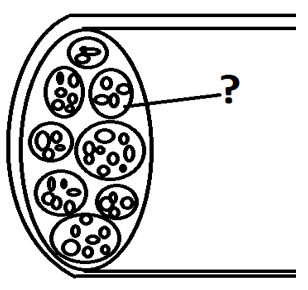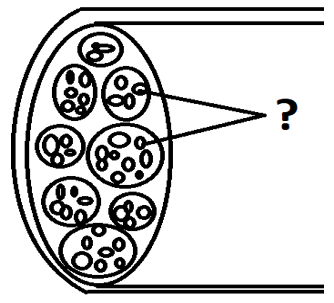This set of Class 11 Biology Chapter 20 Multiple Choice Questions & Answers (MCQs) focuses on “Locomotion and Movement”. These MCQs are created based on the latest CBSE syllabus and the NCERT curriculum, offering valuable assistance for exam preparation.
1. Which of these do not involve flagellar movement?
a) Swimming of spermatozoa
b) Maintenance of water current in sponges
c) Locomotion of some protozoans
d) Movement of macrophages in blood
View Answer
Explanation: The movement of macrophages in blood does not involve the use of flagella. Macrophages are phagocytic in nature and are a part of the immune system. They show amoeboid movement.
2. What percentage of body weight of an adult human is contributed by muscles?
a) 20-30%
b) 10-20%
c) 40-50%
d) 30-40%
View Answer
Explanation: 40-50% of the total body weight of an adult human is contributed by muscles. Muscles are required for numerous processes of the body in order to survive and locomote. They are of mesodermal origin.
3. Which of these is not a property of muscles?
a) Extensibility
b) Excitability
c) Degradability
d) Elasticity
View Answer
Explanation: 40-50% of the total body weight of an adult human is contributed by muscles. Muscles have several properties such as elasticity, extensibility, excitability and contractibility. Degradability is not a property.
4. Which of these is not a basis of classification for muscles?
a) Excitability
b) Appearance
c) Location
d) Regulation of activities
View Answer
Explanation: Muscles have several properties such as elasticity, extensibility, excitability and contractibility. Muscles can be classified on the basis of appearance, location and regulation of activities.
5. Which of these statements is not true regarding skeletal muscles?
a) They are also called voluntary muscles
b) They help in the movement of food through the oesophagus
c) They have striations
d) They are involved in changing of body posture
View Answer
Explanation: Skeletal muscles are also known as voluntary muscles. They have striations and are also known as striated muscles. They are involved in changing of body posture but not in the movement of food through the oesophagus.
6. Which of these is not a characteristic of cardiac muscles?
a) They work continuously
b) They are branched
c) They are not striated
d) They are involuntary
View Answer
Explanation: Cardiac muscles are the muscles of the heart. Cardiac muscles are involuntary muscles that work continuously to pump blood throughout the body. They are branched and are striated in appearance.
7. What is fascia made of?
a) Collagen
b) Keratin
c) Microtubules
d) Muscle fibres
View Answer
Explanation: Fascia is a layer of connective tissue that surrounds the fascicles or muscle bundles in a muscle. It is made out of collagen. Each muscle bundle contains a number of muscle fibres or muscle cells.
8. Identify the structure shown in the figure.

a) Fascia
b) Muscle fibre
c) Sarcolemma
d) Fascicle
View Answer
Explanation: The diagram given is that of the cross-sectional view of a muscle. The structure shown is a fascicle or a muscle bundle. A number of fascicles or muscle bundles are surrounded by a collagenous fascia.
9. Identify the structure shown in the figure.

a) Fascicle
b) Muscle bundles
c) Muscle fibres
d) Fascia
View Answer
Explanation: The diagram given is that of the cross-sectional view of a muscle. The structures shown are muscle fibres or muscle cells. A number of muscle fibres are grouped together into a muscle bundle.
10. A muscle fibre is a syncytium. True or false?
a) True
b) False
View Answer
Explanation: A muscle fibre or a muscle cell possesses many nuclei or is multinucleated. Hence, it is a syncytium. A number of muscle fibres or muscle cells are grouped together into a muscle bundle or fascicle.
11. Which of these ions are abundant in the sarcoplasmic reticulum?
a) Magnesium
b) Sodium
c) Potassium
d) Calcium
View Answer
Explanation: The sarcoplasmic reticulum is the endoplasmic reticulum present in the sarcoplasm of the muscle cell or the muscle fibre. The sarcoplasmic reticulum contains a large number of calcium ions.
12. Which of these structures has alternate dark and light bands on it?
a) Fascicles
b) Sarcolemma
c) Myofibrils
d) Fascia
View Answer
Explanation: Each muscle cell or muscle fibre contains filaments in its sarcoplasm which are arranged in a parallel manner. These filaments are known as myofibrils and they have alternate dark and light bands.
13. What does the A band of a myofibril contain?
a) Troponin
b) Actin
c) Myosin
d) Tropomyosin
View Answer
Explanation: The A band or anisotropic band contains the protein myosin. The A band is also known as the dark band. The light bands, also called the I bands or the isotropic bands contain the protein actin.
14. Which of these statements is false regarding myofibrils?
a) The A band is also known as the light band
b) Myosin is parallel to the longitudinal axis of myofibril
c) Light bands contain actin
d) Anisotropic bands contain myosin
View Answer
Explanation: Actin and myosin lie parallel to the longitudinal axis of the myofibril and also to each other. The A band or the anisotropic band or the dark band contains myosin while the light band contains actin.
15. Actin filaments are thicker than myosin filaments. True or false?
a) True
b) False
View Answer
Explanation: Actin and myosin lie parallel to the longitudinal axis of the myofibril and also to each other. The A band contains myosin while the light band contains actin. Actin filaments are thinner than myosin filaments.
More MCQs on Class 11 Biology Chapter 20:
- Chapter 20 – Locomotion and Movement MCQ (Set 2)
- Chapter 20 – Locomotion and Movement MCQ (Set 3)
- Chapter 20 – Locomotion and Movement MCQ (Set 4)
- Chapter 20 – Locomotion and Movement MCQ (Set 5)
To practice all chapters and topics of class 11 Biology, here is complete set of 1000+ Multiple Choice Questions and Answers.
If you find a mistake in question / option / answer, kindly take a screenshot and email to [email protected]
- Check Class 11 - Books
- Practice Class 11 - Mathematics MCQs
- Practice Class 11 - Chemistry MCQs
- Practice Class 12 - Biology MCQs
- Practice Class 11 - Physics MCQs
